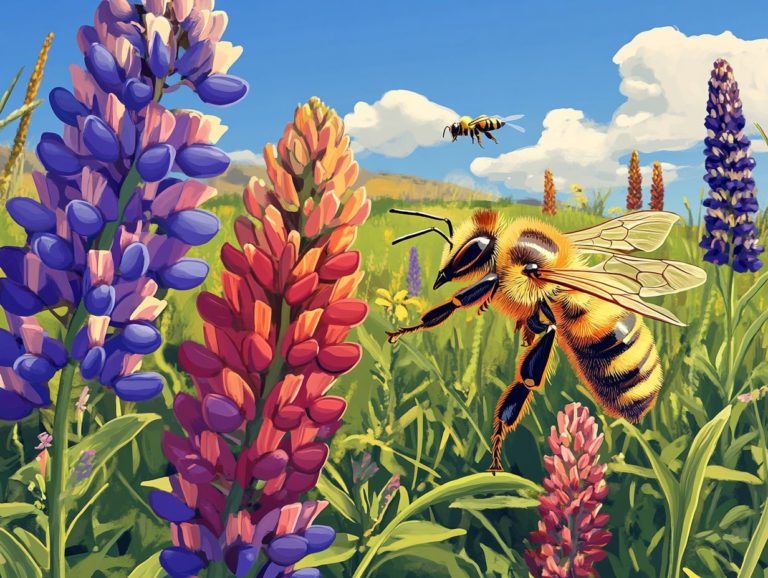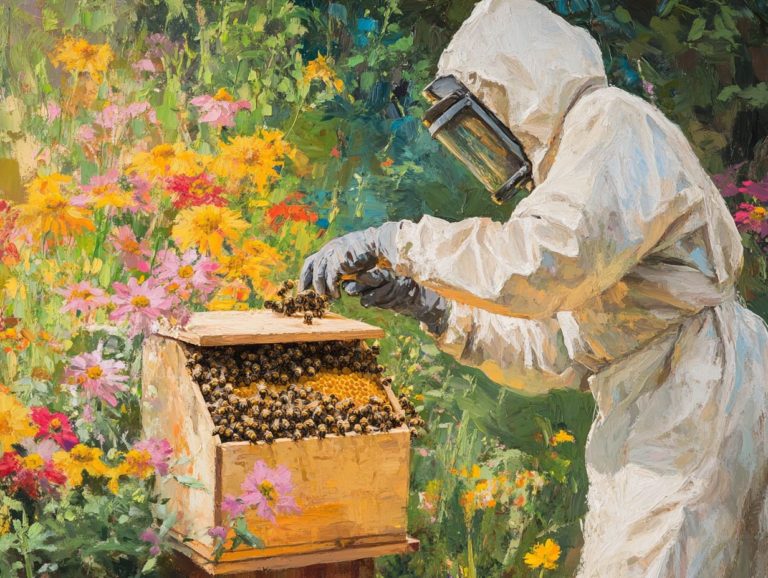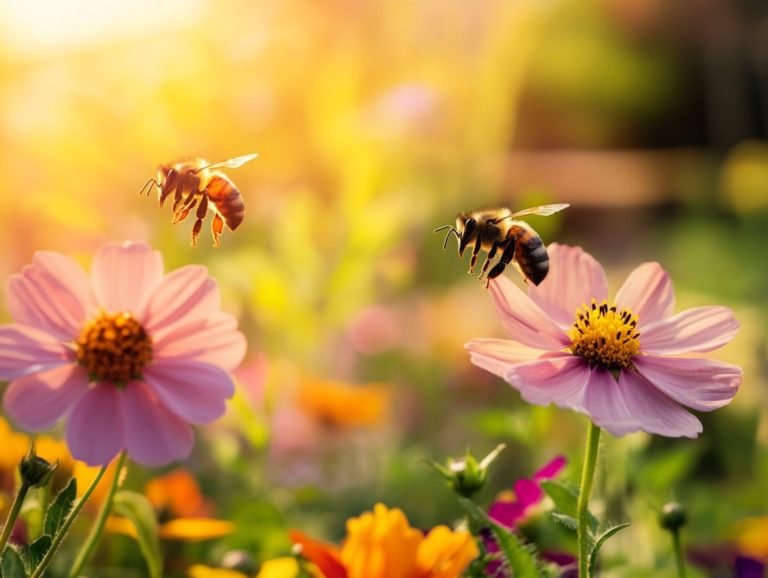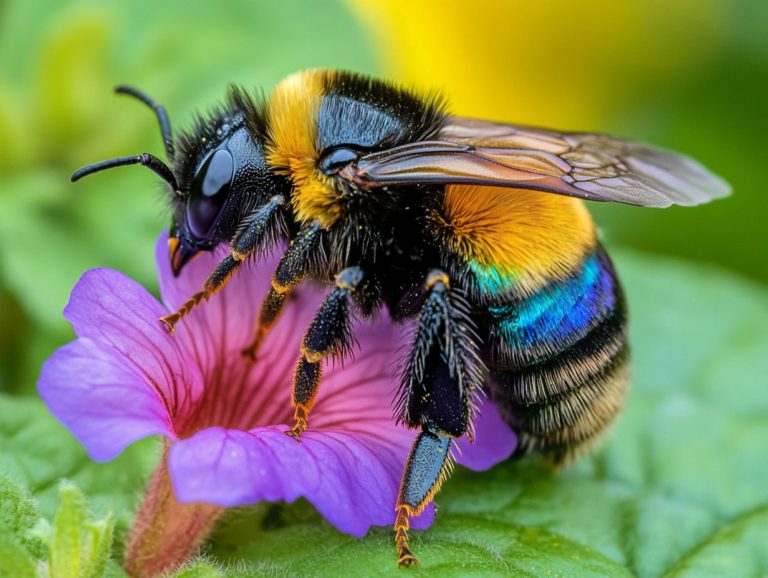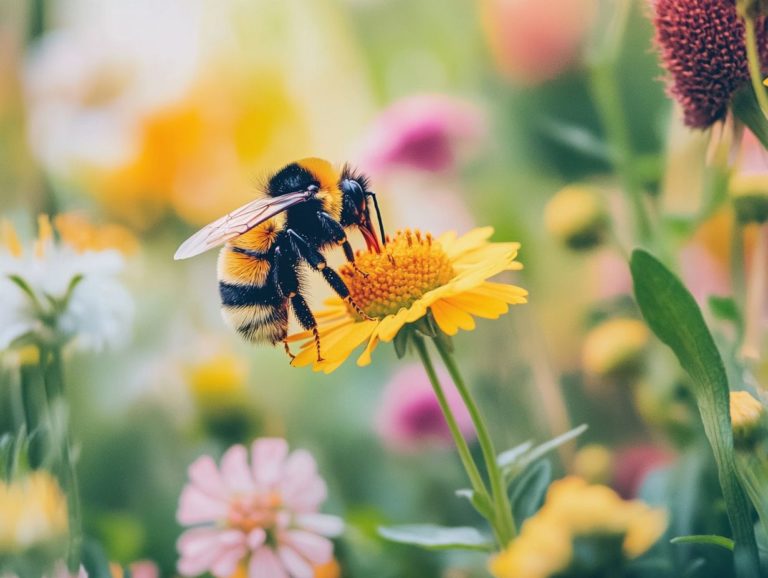Understanding Bee Aggression and Defense
Bees are essential to our ecosystem, yet their behavior is often misunderstood. This misunderstanding leads to unwarranted fear and misconceptions about their aggression. These social organisms play a critical role in pollination and maintaining biodiversity.
This article delves into the fascinating realm of bee aggression. It explores the triggers behind this behavior and the ways bees defend their hives. You will find practical tips for safely interacting with aggressive bees and strategies to protect yourself from stings. Additionally, it highlights the numerous benefits that bees and beekeeping contribute to our environment. It also emphasizes the importance of understanding bee behavior and the role of beekeeping associations in promoting best practices.
Furthermore, it outlines effective methods to create bee-friendly habitats and promote their conservation. Jump in to discover how you can coexist in harmony with these amazing creatures!
Contents
Key Takeaways:

- Protect your hive: Bee aggression is a natural response to guard their home from potential threats.
- Learn defense mechanisms: Bees use stinging and chemical signals, called sting pheromones, to protect their hives.
- Stay calm: When dealing with aggressive bees, it is important to remain calm and take precautions to avoid being stung. Good care of the bee colony can significantly reduce aggressive tendencies.
What is Bee Aggression?
Bee aggression refers to the behavioral tendencies of honey bee colonies, particularly Apis mellifera, to exhibit aggression when they sense threats to their hive or resources.
This instinctive behavior serves as a natural defense mechanism to protect the colony’s queen and brood box from potential dangers, whether they come from environmental factors or intruders.
Understanding the nuances of bee aggression is essential for good care of the bee colony. It also helps ensure a bountiful honey harvest. Aggressive bees can present significant challenges during inspections, especially for those still honing their beekeeping skills. It is imperative to approach these situations with knowledge and confidence.
What Causes Bees to Become Aggressive?
Bees can display aggressive behavior for various reasons. These include environmental factors such as changes in nectar flow, the inherent characteristics of their colony, and stressors like being queenless or subjected to physical disturbances.
Additionally, reactive behavior can be influenced by genetic traits and the overall temperament of the colony. These triggers for aggression are often worsened by external conditions, such as temperature fluctuations and resource scarcity.
For example, during scorching heat, bees may become more defensive as they contend with stress and dehydration. Additional stressors can arise from limited nectar availability, creating competition among colonies and prompting a heightened pheromone response.
This chemical signaling significantly influences bee behavior, leading to an increase in defensive actions when the hive senses potential threats. Grasping these dynamics is essential for beekeepers who wish to cultivate harmonious colonies and temper aggressive tendencies.
What is Bee Defense?
Bee defense involves the intricate mechanisms and strategies that honey bees utilize to safeguard their colonies against threats and predators. This ensures the survival of their social structure and the queen bee.
These defensive patterns are crucial for maintaining a calm colony and effective beekeeping. The defenses encompass both physical tactics, such as stinging, and chemical signals like the release of sting pheromones, which act as alarms to rally defensive bees.
Gaining insight into these defensive behaviors is vital for effective colony management. This knowledge equips you to navigate potential aggressiveness during inspections and honey production with confidence and care.
How Do Bees Defend Their Hives?
Bees employ a fascinating array of defensive mechanisms to protect their hives, primarily involving the diligent worker bees that spring into action at the first sign of a threat. When danger is detected, they engage in aggressive behavior by releasing sting pheromones, which alert the rest of the colony.
Along with these chemical signals, bees practice vigilant guarding at the hive’s entry points, ensuring that only authorized members gain access. During colony evaluations, any indication of intrusion triggers a swift response, with workers ready to defend their queen and brood with fierce determination. Their collective communication enhances the effectiveness of their defense strategy, allowing for a seamless and coordinated reaction.
By working together, bees can effectively deter predators and intruders, showcasing an impressive level of teamwork within the colony. This multifaceted approach highlights the sophisticated management techniques bees utilize, which not only safeguard the hive but also ensure the survival of the entire colony.
What Are the Different Types of Bee Defense Mechanisms?
The various types of bee defense mechanisms encompass both physical actions, like stinging, and behavioral responses driven by chemical signals, such as the release of pheromones that initiate collective defensive strategies within the colony. Understanding these dynamics helps beekeepers keep colonies calm and manage aggressive tendencies.
These mechanisms are essential for the survival of bees, particularly when confronted with threats from predators or environmental challenges. For example, the act of stinging serves not only as an immediate physical defense but also reinforces the overall aggression characteristic of these remarkable insects. The sting is just the beginning; bees also communicate danger through pheromones, alerting nearby colony members to react quickly.
When a hive faces threats, whether from bear attacks or human disturbances, these integrated strategies highlight how bees utilize both individual initiative and collective strength to fend off danger. By grasping the environmental influences that shape bee behavior, you can gain a deeper appreciation for the intricate dynamics that drive their defensive responses.
How to Handle Aggressive Bees?
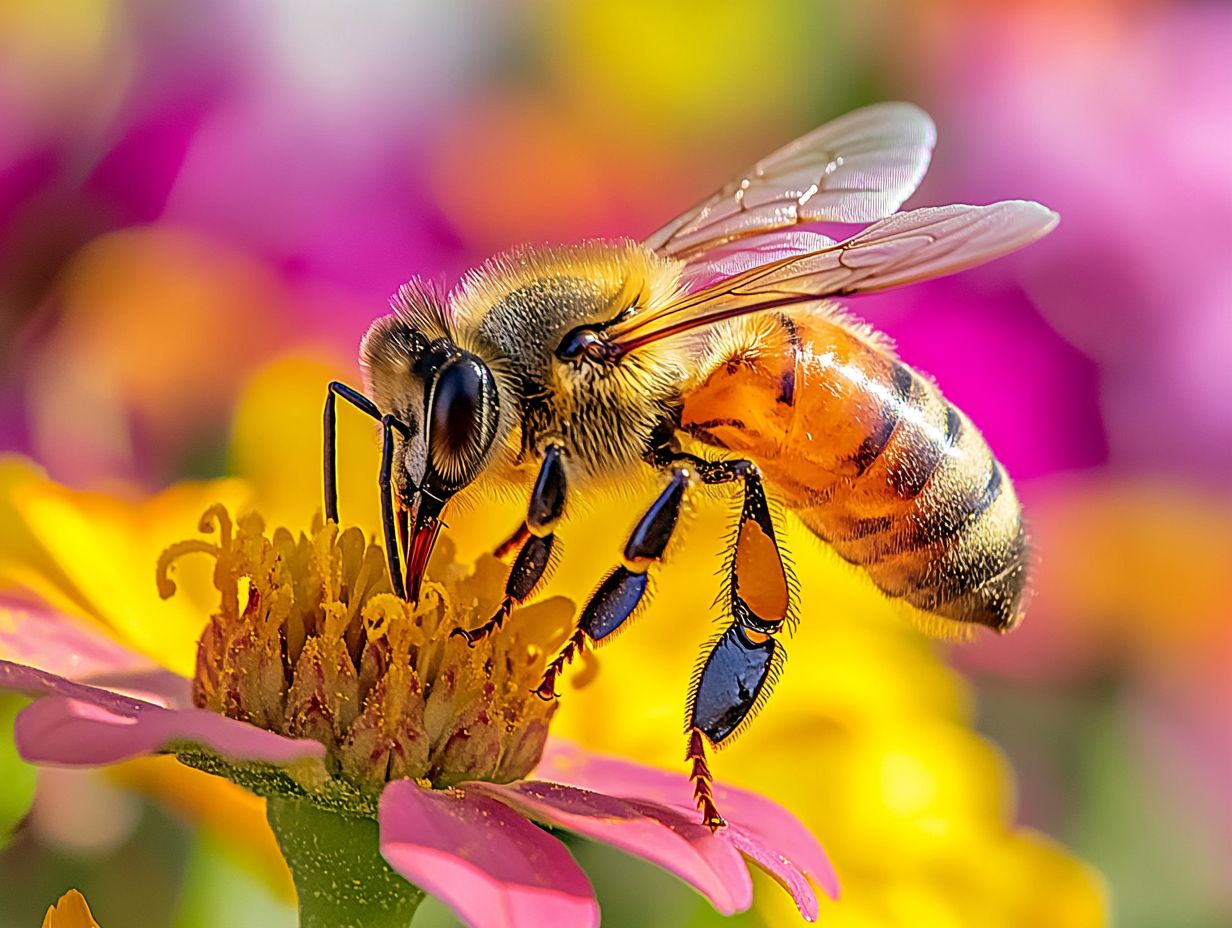
Handling aggressive bees demands a distinct set of skills every beekeeper needs to navigate these situations safely and effectively. It’s essential for you to understand how bees act and to implement strategies that address their aggressive tendencies.
By taking precautions like donning protective gear, utilizing smoke to soothe the bees, and approaching the colonies during their calmer periods, you can significantly mitigate the risks associated with bee stings.
What Precautions Should Be Taken When Dealing with Aggressive Bees?
When you find yourself in the presence of aggressive bees, take precautions to stay safe and minimize the risk of stings. Equip yourself with protective gear, such as bee suits and veils, and consider using smoke to calm the colony before you begin any inspections.
To enhance your safety while managing bees, timing your inspections for the late morning or early afternoon is wise. During these hours, bees are less likely to be busy foraging, making your experience more manageable.
Maintaining a calm demeanor is crucial; sudden movements or loud noises can easily provoke defensiveness from the hive. Being attuned to signs of aggression like buzzing or erratic flying can help you gauge the bees’ mood.
Keep an eye on environmental factors, such as temperature fluctuations or nearby disturbances, as they can significantly affect bee behavior and how they respond to your presence. Being aware of these environmental influences is key to preventing defensive behavior.
What Are Some Tips for Calming Aggressive Bees?
To calm aggressive bees, you can employ a variety of techniques, with smoke being a favored tool. This method temporarily masks the warning scents, soothing the bees and significantly reducing the likelihood of defensive behavior during colony management.
Gentle handling is essential for maintaining a harmonious hive environment. By moving slowly and deliberately, you help reduce stress among the bees, fostering a sense of security within the colony.
It’s equally important to maintain a calm demeanor; sudden movements or loud noises can easily trigger defensive responses. By integrating these practices, you not only ensure your own safety but also promote healthier colonies, which ultimately leads to improved honey production. This approach benefits both the bees and the beekeeper.
When bees feel secure and undisturbed, they become more inclined to engage in foraging and activities that positively contribute to the hive’s productivity and overall health. This balance is essential for effective bee management and honey production.
How to Protect Yourself from Bee Stings?
Staying safe from bee stings is vital for anyone near bees! Protecting yourself is crucial if you re involved in beekeeping or simply spending time near honeybee colonies. Those stings can lead to painful reactions and, in some cases, trigger serious allergic responses.
Understanding how colonies react to physical stimuli can enhance your safety and effectiveness as a beekeeper. By wearing protective gear like gloves, veils, and suits, you can significantly decrease your chances of encountering a sting. Taking the time to comprehend bee behavior will help you manage your apiary, allowing you to enjoy the fascinating world of bees with greater peace of mind.
What Are the Symptoms of a Bee Sting?
The symptoms of a bee sting can differ based on your individual reaction, but you can typically expect immediate pain, swelling, and redness at the sting site. For some, the response may escalate into more severe allergic reactions that require medical attention. Being aware of these potential reactions is crucial for anyone involved in apiary management and beekeeping practices.
Understanding the range of reactions is essential for effective first aid and prevention. Generally, a typical reaction involves localized discomfort and inflammation that you can manage with simple first aid measures, like applying cold compresses or taking antihistamines. Bee stings are often caused by aggressive bees, particularly during colony inspections or disturbances around the apiary.
However, a small percentage of the population faces a more serious threat: anaphylaxis. This life-threatening reaction can strike suddenly, leading to symptoms like difficulty breathing, swelling of the throat, and a rapid drop in blood pressure. It is often triggered by pheromone response and defensive behavior. Such severe responses demand immediate emergency intervention, underscoring the importance of recognizing and acting swiftly.
To reduce the risk of stings, educate yourself about bee behavior, steer clear of areas buzzing with activity, and don protective clothing when necessary. Effective colony management and apiary management practices also play a crucial role.
What Are Some Natural Remedies for Bee Stings?
Natural remedies for bee stings can offer effective pain relief and help reduce swelling at the sting site, especially when dealing with aggressive tendencies of certain bee species. Consider using common treatments such as ice, vinegar, baking soda, and herbal remedies, which can ease your discomfort without relying on pharmaceuticals.
These home treatments work in harmony with your body s natural healing processes while minimizing side effects, making them a safe choice for many. Ice packs can numb the pain and reduce inflammation, while vinegar helps neutralize the acidity of the sting, providing swift relief. Mixing baking soda with water creates a soothing paste that alleviates irritation and draws out toxins. Herbal options like aloe vera and honey boast anti-inflammatory properties that can enhance your healing experience.
Understanding bee behavior and responding promptly can make a significant difference in how you manage the effects of a sting, allowing for a more comfortable recovery. Understanding these natural remedies empowers you to take control of your recovery after a sting.
What Are the Benefits of Bees and Beekeeping?
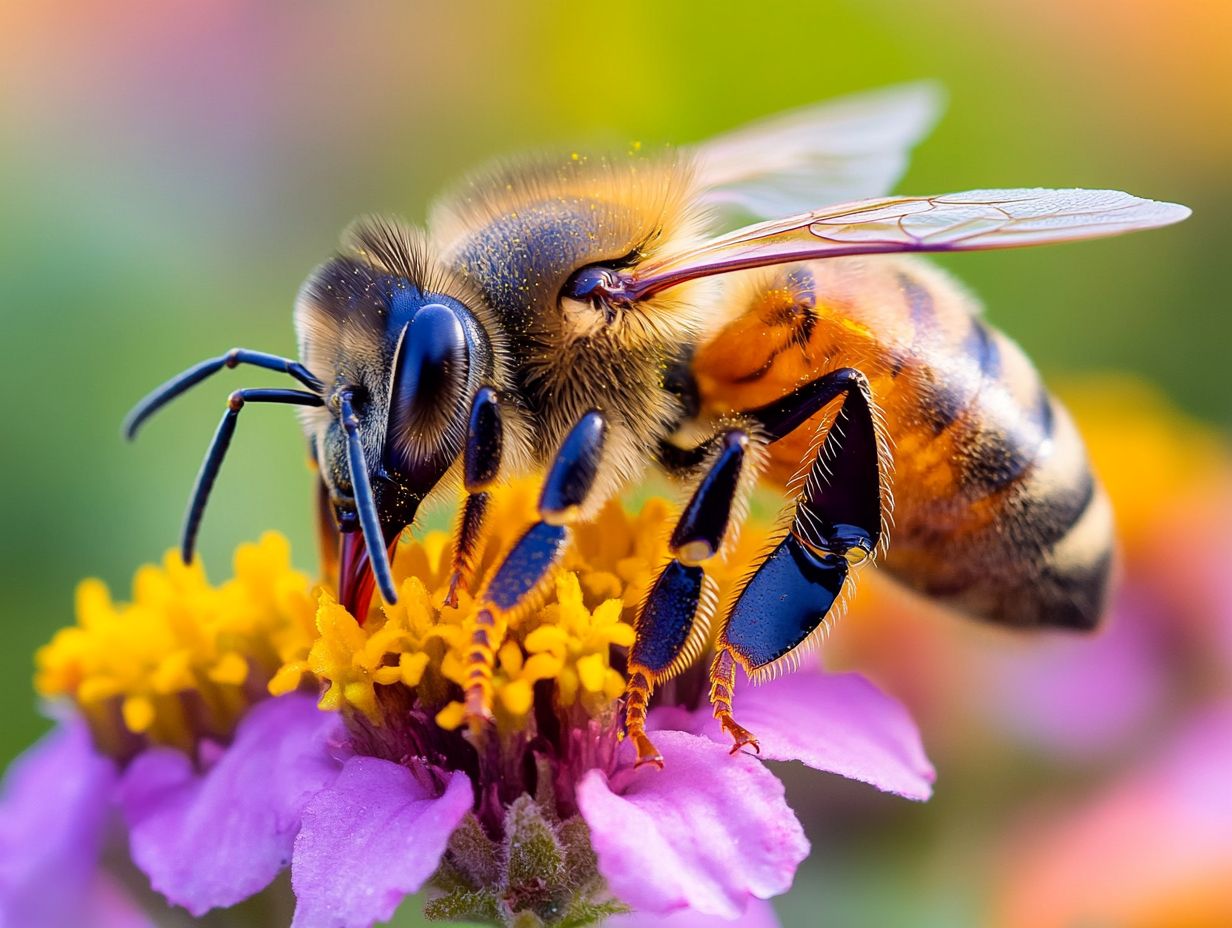
Bees hold an essential position in our ecosystem, offering invaluable contributions through their pollination efforts and honey production. These activities are crucial for the health of agricultural systems and the preservation of biodiversity.
Engaging in beekeeping not only supports these benefits but also cultivates community involvement and heightens environmental awareness. It encourages sustainable agricultural practices.
By joining a beekeeping association, you can significantly enhance your skills and knowledge. This contributes to the well-being of honey bee colonies and promotes care for the environment.
How Do Bees Contribute to the Ecosystem?
Bees are essential to the ecosystem, serving as primary pollinators that significantly enhance biodiversity. The Apis mellifera, or western honey bee, is particularly noted for its critical role. They facilitate the reproduction of flowering plants, including numerous agricultural crops crucial for food production and rural development.
Your understanding of their pollination activities reveals how they boost the yields of a wide array of fruits, vegetables, and nuts. This also supports the overall health of ecosystems.
Knowledge of honey bee traits and colony characteristics is essential. By promoting plant diversity, bees play a vital role in maintaining habitat stability and resilience against environmental challenges.
The intricate relationships they cultivate between plants and animals highlight the interconnectedness of life. This underscores the critical role bees play in sustainable agricultural practices.
Understanding insect behavior and environmental influences is crucial in this context. As factors like climate change and habitat loss pose serious threats to bee populations, recognizing their importance is vital for safeguarding food security and preserving the balance of our natural world.
Active bee management and colony evaluations are necessary for this effort.
What Are the Benefits of Beekeeping for Humans?
Beekeeping presents a wealth of benefits that extend far beyond the production of honey and other bee products. This includes the maintenance of honeycomb structure and prevention of bee stings. These treasures are not only delicious sources of nutrition but also offer remarkable health advantages, thanks to their natural properties and antimicrobial effects.
Honey production is a key aspect of this practice. It can significantly boost economic development in your community, especially through small businesses and training apiary programs.
Local honey production can create sustainable income streams for beekeepers, supporting small businesses and fostering a vibrant local economy.
The educational aspects of beekeeping encourage you to become an environmental steward. You will gain insight into the vital role pollinators, particularly Apis mellifera, play in agriculture and the overall health of ecosystems.
Engaging in beekeeping allows you to promote sustainable farming practices, ensuring agricultural systems remain resilient and productive while protecting our planet.
Understanding how bee colonies react to changes in their environment is integral to this process. By immersing yourself in this rewarding activity, you ll forge meaningful connections within your community, cultivate a deeper appreciation for nature, and play a crucial role in conserving essential bee populations, including managing queenless colony conditions.
How to Prevent Bee Aggression and Protect Bee Populations?
To prevent bee aggression and protect bee populations, embrace a multifaceted approach. This includes understanding colony aggression and aggressive behavior. Adopt effective beekeeping practices, gain a deep understanding of environmental influences, and manage your colonies to mitigate stressors linked to aggressive behavior.
Techniques like apiary management and breeding colonies for calmer traits are beneficial. By doing so, you can create a harmonious environment that supports both the bees and your beekeeping endeavors.
What Are Some Ways to Promote Bee-Friendly Environments?
Promoting bee-friendly environments means creating habitats that support bee health and diversity. You can achieve this by planting native flowers and reducing pesticide use.
You can also take proactive steps in your garden. Incorporate a variety of flowering plants that bloom at different times throughout the year.
Utilizing ways to take care of bees can help ensure a reliable food source for them. This ensures bees have a continuous food source across the seasons.
Communities can make a huge difference! Organizing workshops and campaigns can educate the public about the critical importance of bees and the environmental challenges they face.
Such initiatives raise awareness about sustainable practices that benefit both bees and the ecosystem. Establishing local bee gardens or pollinator parks can act as community hubs for education and engagement.
These parks provide essential habitats for important pollinators. By advocating for reduced chemical use in landscaping and supporting local farmers who embrace bee-friendly practices, you contribute to a healthier ecosystem.
This ecosystem celebrates biodiversity and supports our buzzing friends.
What Can Individuals Do to Help Protect Bees?
You can play a crucial role in protecting bees through meaningful actions. Support local conservation programs and raise awareness about the importance of pollinators.
Creating bee-friendly spaces in your garden or community are also impactful steps. By actively engaging in community initiatives that prioritize eco-friendly practices, you help cultivate a healthier environment for these essential creatures.
Consider joining local groups that advocate for bee-friendly policies. Volunteering for habitat restoration projects or organizing educational workshops can significantly bolster bee conservation initiatives.
Encouraging your neighbors to plant native flowers and reduce pesticide usage can transform your community into a welcoming haven for bees. Participate in citizen science projects to contribute valuable data about bee populations.
This reinforces your commitment to preserving these vital pollinators and understanding behavioral traits and colony responses.
Frequently Asked Questions
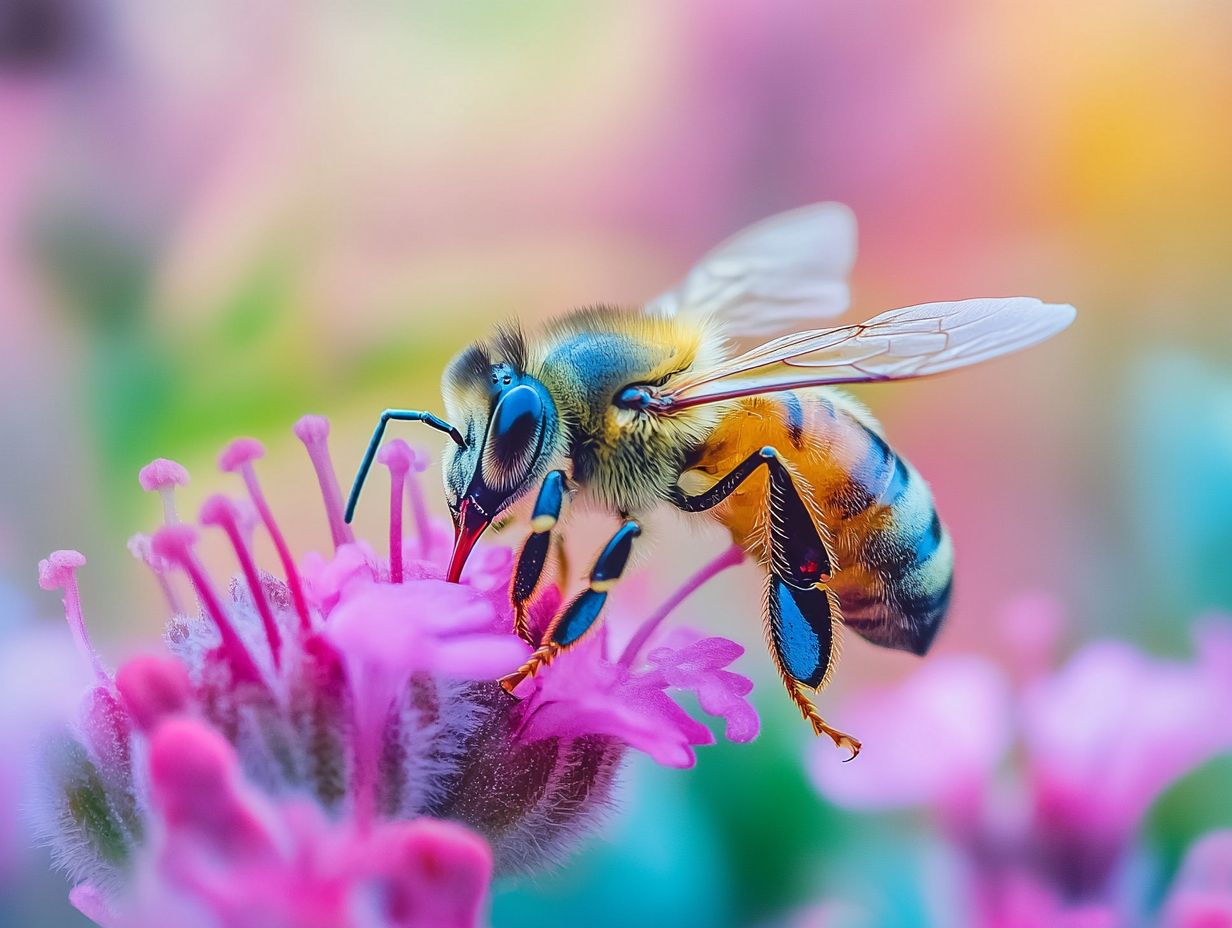
What is bee aggression and defense?
Bee aggression and defense refers to the behaviors exhibited by bees when they feel threatened or sense a potential threat to their colony. This includes defensive mechanisms and patterns seen in worker bees.
Behaviors can include stinging, attacking, and releasing chemical signals to warn other bees. These signals are known as chemical cues or pheromones.
Why do bees exhibit aggression and defense?
Bee aggression and defense are natural instincts that help protect the colony and ensure its survival. Genetic traits influence the level of defensiveness.
Bees defend their hive and resources from potential predators or other threats. They often exhibit reactive behavior in response to physical stimuli.
How do bees communicate during aggression and defense?
Bees use various signals, including sound and pheromones, to communicate about potential threats. Defensive behavior is triggered by these chemical cues.
They may also use physical gestures to warn other bees of danger, especially in queen bee led colonies.
Are all bees equally aggressive?
No, not all bees exhibit the same level of aggression. The calm colony concept contrasts with colonies showing high aggressive tendencies.
Some bee species are more docile and less likely to exhibit aggressive behaviors, while others are known for their defensive nature. Understanding bee aggression and its causes is essential for effective bee management practices, which often involve selecting specific breeding lines to enhance desired traits.
What Can Trigger Bee Aggression and Defense?
Bee aggression can be triggered by various factors, including sudden movements, strong scents, and vibrations. Changes in their surroundings, the presence of predators, or disturbances to their colony can also make bees aggressive, especially if they are stressed or lack a queen bee, the main female bee that lays eggs.
How Can Humans Protect Themselves from Bee Aggression?
Protect yourself from bee aggression! Stay calm and avoid sudden movements when near bees. Wear protective clothing and skip strong scents that might attract them. If a bee approaches, slowly back away. Do not swat or irritate the bee. Beekeeping groups suggest these practices to care for bee colonies effectively and reduce aggression.


